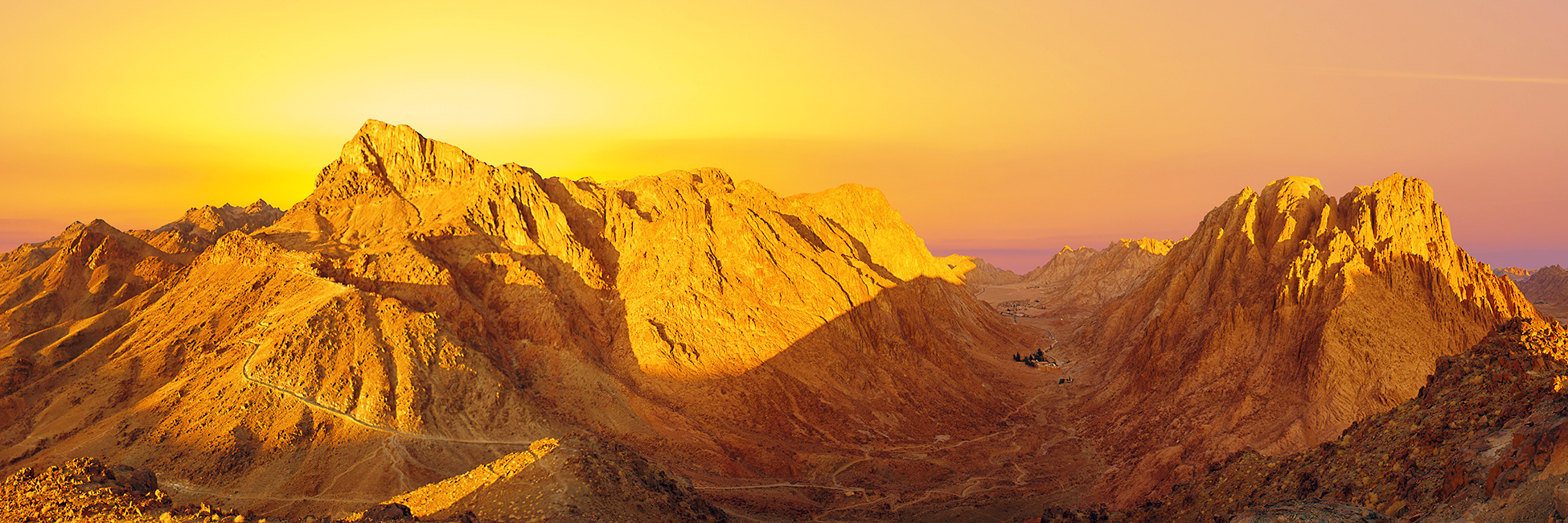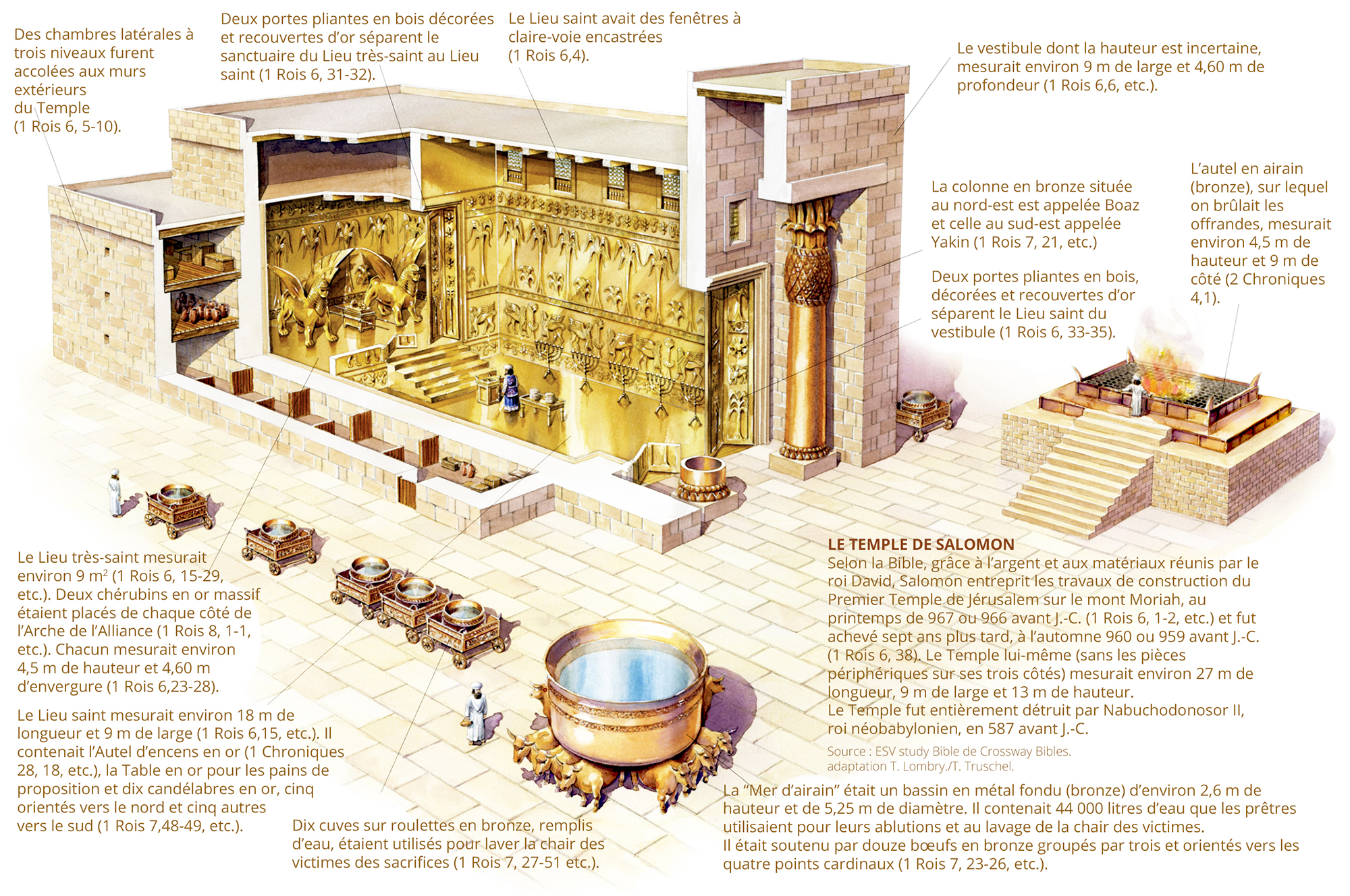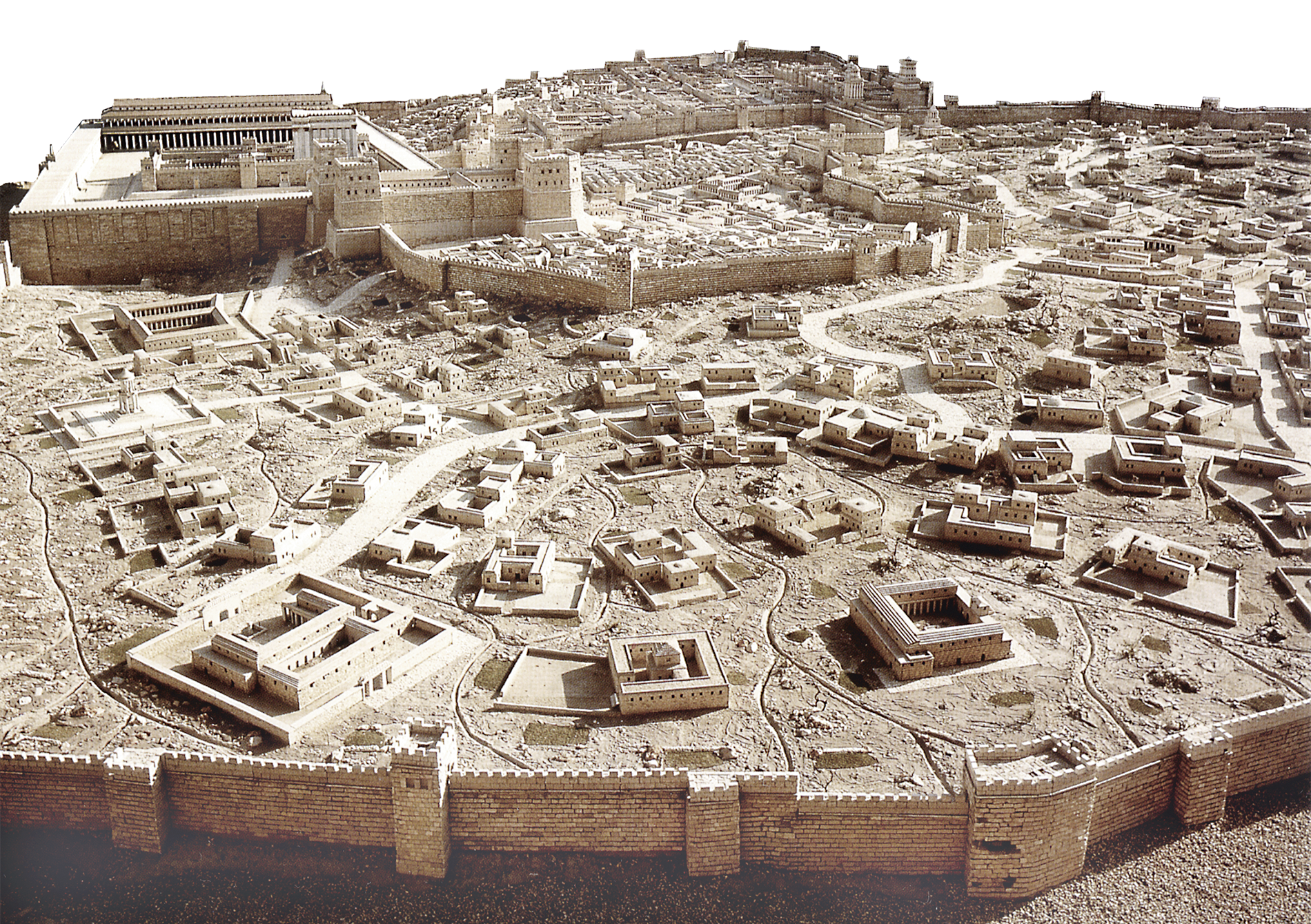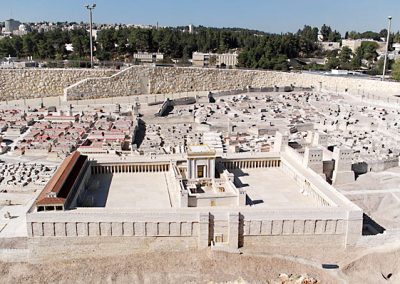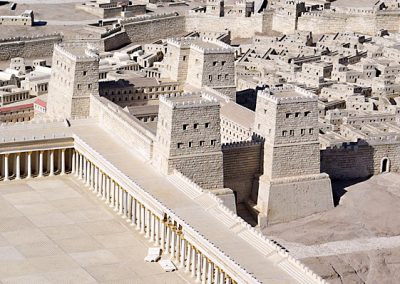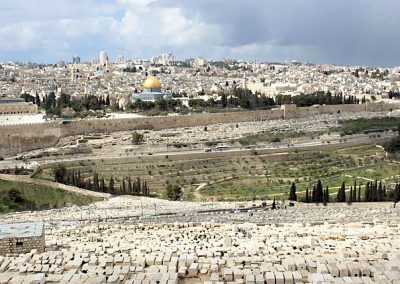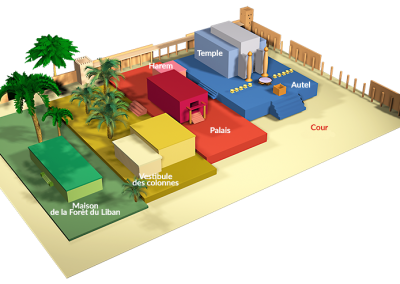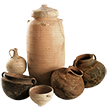
Bible, History, Archeology
Bible,
History,
Archeology
The Four Temples in the Bible
In this text, we have deliberately left out the Temple from the vision of Ezekiel and the one mentioned by the apostle John in the Apocalypse, both temples being within the framework of a prophetic vision.
According to the Holy Scriptures, four temples were erected among the people of Israel:
The Tabernacle
Unlike the three temples which succeeded it, the Tabernacle was an edifice made up of elements that were entirely dismountable and transportable. It was intended as a sanctuary during the Hebrew people’s peregrinations in the Sinai Desert, probably between the fourteenth and twelfth centuries BC.
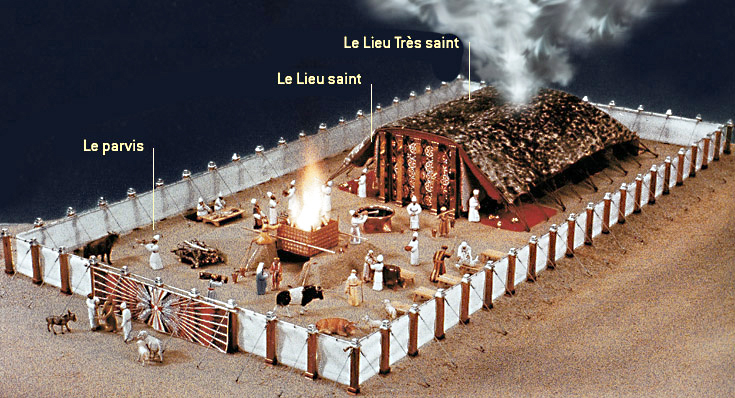 The Tabernacle, a word meaning “tent”, (from the hebrew word, mishkanor “Tent of Assignment”, i.e. the dwelling place of the Testimony, of the Law), was a “mobile” sanctuary. Its importance in Scripture is seen in 13 chapters of the book of Exodus: chapters 25 to 31 and 35 to 40. To this must be added numerous references in Leviticus, Numbers, Deuteronomy and even in chapters 8 and 9 of the book of Hebrews, in the New Testament. To this must be added numerous references in Leviticus, Numbers, Deuteronomy and even in chapters 8 and 9 of the book of Hebrews, in the New Testament.
The Tabernacle, a word meaning “tent”, (from the hebrew word, mishkanor “Tent of Assignment”, i.e. the dwelling place of the Testimony, of the Law), was a “mobile” sanctuary. Its importance in Scripture is seen in 13 chapters of the book of Exodus: chapters 25 to 31 and 35 to 40. To this must be added numerous references in Leviticus, Numbers, Deuteronomy and even in chapters 8 and 9 of the book of Hebrews, in the New Testament. To this must be added numerous references in Leviticus, Numbers, Deuteronomy and even in chapters 8 and 9 of the book of Hebrews, in the New Testament.
Image above: general view of theTabernacle with the cloud which reminded the people of God’s presence. (Shekina). It faced the rising sun. © D.R.
To view the page of the Tabernacle in the desert →
Construction
The Scriptures tell us how Moses received the vision of the Tabernacle on Mount Sinai, along with the instructions on how to have it built, so it would be the “Dwelling Place of God” in the midst of his people.
The layout of the Tabernacle, with its three parts: the Court, the Holy Place, and the Most Holy Place, was therefore designed according to the precise instructions of the Lord. It was directed eastward facing the rising sun. It was directed eastward facing the rising sun.
The tabernacle was placed in the center of the twelve tribes of Israel, which were assigned specific locations and specific functions. This was especially the case for the Levites who were responsible for the various furnishings of the tabernacle under the direction of the High Priest.
Sunrise on the probable Mountain of Moses in southern Sinai. © Mountains Hunter. 1246113445. © Mountains Hunter. 1246113445.
Salomon’s Temple – The first Temple
The first Temple was built in Jerusalem in the 10th century BC. According to the Scriptures, its construction began in the fourth year of Solomon’s reign (~ 964 BC) and was completed within seven years and six months. It was completely torn down and destroyed in 586 B.C. by Nebuchadnezzar II’s Neo-Babylonian armies (The Nebuchadnezzar of the Bible).
Its construction
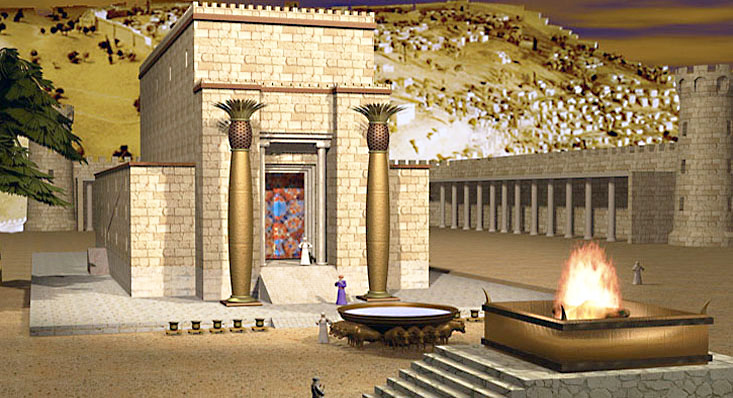 For this project, King David gathered not only precious materials but also a considerable sum of money for the time. He made an alliance with Hiram, king of Tyre, who provided him with cedar wood.
For this project, King David gathered not only precious materials but also a considerable sum of money for the time. He made an alliance with Hiram, king of Tyre, who provided him with cedar wood.
The shrine was erected by Solomon on Mount Moriah at the site of the threshing floor of Ornan the Jebusite (2nd Chronicles 3:1), and at the site of “the binding of Isaac” (traditionally called the sacrifice of Isaac).
The general plan reproduced that of the Tabernacle, but its dimensions were larger and its decorations more sumptuous.
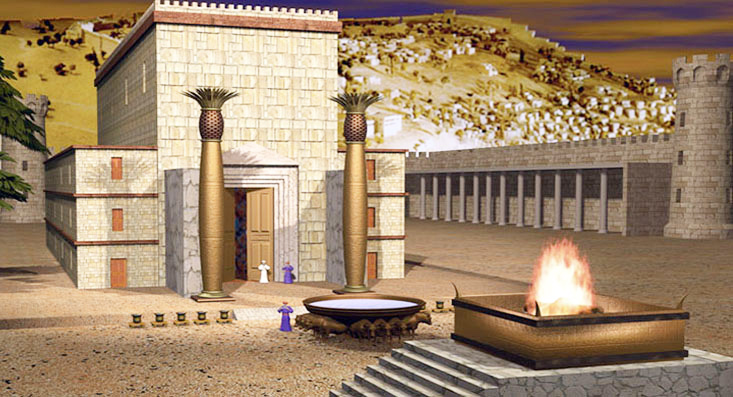 Images above : two possible versions of the Temple of Solomon.
Images above : two possible versions of the Temple of Solomon.
Top image: the version with the covered vestibule.
Bottom image: The version with the open vestibule.
© Théo Truschel.
The interior of the sanctuary was 60 cubits long and 20 cubits wide; its height of 30 cubits (1st Kings 6:2) differed from that of the Tabernacle, which was only 10 cubits high (the cubit is estimated to be about 47 cm). The Temple consisted of three distinct parts: The Courtyard, the Holy Place, and the Most Holy Place.
The walls were made of cut stone from top to bottom. Numerous cherubs, palms, and flowers were carved on the walls. The roof and ceiling were made of cedar from Lebanon (1st Kings 6:9). The floor was made of cypress planks. The entire interior was plated with gold: “And the whole house was covered with gold,” (1st Kings 6:22).
The Temple’s destruction
Throughout the Royal Period of Israel, many kings drew from the treasures of the Temple to buy political power or peace. It was during the reign of King Josiah (~ 640-609 BCE) that major restoration work was undertaken (2nd Kings 22:4).
In 586 BC, Jerusalem was besieged and taken, and the Temple was looted and destroyed by the Neo-Babylonian army of King Nebuchadnezzar II.
There remains no trace today of the work undertaken by Solomon. Subsequent construction on and around the Temple Mount, particularly that of Herod, erased the older structures which had been there The current archaeological excavations which would allow to find some remains of the Temple of Solomon are facing insurmountable political and religious obstacles, because it would affect the Esplanade of the Mosques, a muslim place of worship which is situated in its probable location.
In the absence of direct evidence, we can consider the following:
– The existence of a fortified temple built at Arad, northeast of Beer-sheba, dating back to the 10th century BC. (probably from the time of Solomon) of which the general configuration: a Holy Place, a Most Holy Place, and an altar built of rough stones held together by clay according to a prescription of Exodus 20:25, corresponds to a hebrew place of worship.
– The recent discovery of an ostraca (inscriptions on pottery fragments), dating back to the 8th-7th century BC, which includes the following text:
“…as commanded you by Ashyyahu, the king, to give through Zakaryahu the silver of Tarshish for the Temple of Yahweh: three shekels”.
This offering was intended for the Temple of Yahweh (in other words, the Temple of Jerusalem). This is the first time that such a gift is mentioned in an extra-biblical text. Some have considered it to be an allusion to King Josiah (~ 640 B.C.).
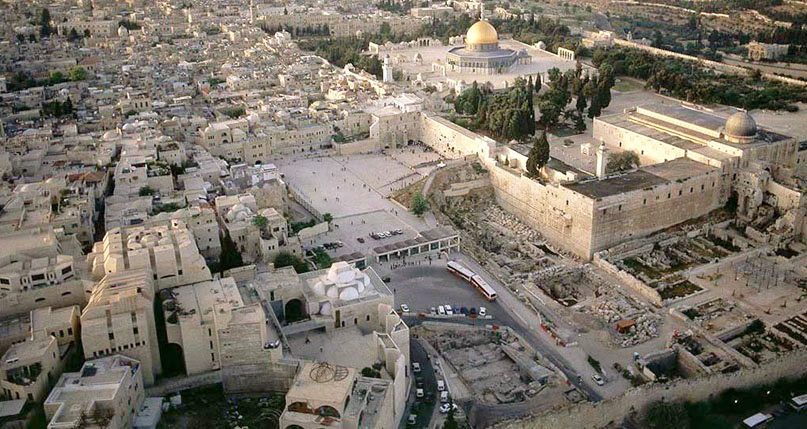 The Temple of Zorobabel
The Temple of Zorobabel
The Second Temple is that of Zorobabel, Prince of Judah. It was rebuilt by the Judeans upon their return from exile around 531 B.C. It is thought to have been completed around 515 B.C. during the time of the Medo-Persian Empire. Little is known about this structure. What we do know is mainly reported in the books of Ezra, Haggai, Nehemiah, and Zechariah and in some historical sources during the reigns of the Hasmonean kings.
Image above: a general aerial view of the Temple Mount in Jerusalem.
One of the few reliable historical sources relating to this period is the work of the Jewish apologist Joseph ben Matthias, also known by the Roman name of Flavius Josephus. Originally a priest in the Temple of Herod the Great in Jerusalem, Josephus became one of the leaders of the Jewish uprising of 66 A.D. in Galilee. This revolt was harshly suppressed by the Romans. After joining the victors of Judea, he accompanied Titus to Rome and began a career as a historian, chronicler and defender of Jewish culture amongst the oligarchs of the Empire. In a controversial work entitled Against Apion, Josephus quotes a description of Jerusalem given by Hecateus of Abatea, a Greek historian who was a contemporary of Alexander the Great and who lived at the end of the fourth century BC. The Temple he describes is the one that was built in the time of Ezra and Nehemiah:
“Near the center (of Jerusalem), a stone wall surrounds an area of five plethrons (a plethron is about 30 meters long and 50 meters wide). This area is accessible through two gates. Within this enclosure is a square altar, built with stones that are neither cut nor sealed, but only assembled. Each side is twenty cubits long (~ 10 meters) and ten cubits high (~ 5 meters). Nearby is a large building containing an altar and a menorah, both of solid gold and weighing two talents” (Contre Apion 1, 198).
In biblical tradition, the period of Persian rule is marked by three major events: the restoration of the Temple (~ 515 B.C.), the reconstruction of the walls of Jerusalem by Nehemiah (~ 445 B.C.), and the promulgation of the Law by Ezra, the priest. These were essential factors in the recovery of the Jewish community after the Babylonian captivity. The need to preserve the Jewish people and their way of life from outside influences was strongly felt.
Three royal decrees were issued in favor of the Jews by the rulers of Persia:
Around 538 B.C., one year after the capture and downfall of Babylon, King Cyrus II the Great suggested to the Judeans that they return to Jerusalem to rebuild the Temple (Ezra 1:1-4). He returned all the utensils of Solomon’s Temple, which had been seized by Nebuchadnezzar II, and appointed Zorobabel governor of the colony. Led by this prince of Judah, the High Priest Joshua and other princes, a number of Jews returned to Jerusalem. Joshua, the religious leader, and Zorobabel, the political leader, raised an altar to the Lord and restored worship (Ezra 3:1-9). Opponents of the Jews then addressed successive Persian kings and succeeded in temporarily halting the work until 520 BC. (2nd year of Darius Hystae).
Around 520 B.C., King Darius encouraged the resumption of the Temple’s construction, which had been halted by the enemies of the Jews (Ezra 6:1-12). Construction of the Temple was completed in the early spring of 515 BC. (Ezra 6:14-15; Haggai 1 and 2 and Zechariah 4). The Second Temple is often called the Temple of Zorobabel. This prince, a descendant of King David, is among the direct ancestors of Jesus-Christ. (Matthew 1:12-13).
Around 445 B.C., Artaxerxes I, son of Xerxes I, wrote an order in favor of Nehemiah, authorizing him to rebuild the wall of the city of Jerusalem (Nehemiah 2:8).
He authorized Ezra and later Nehemiah to return to Jerusalem. He gave Ezra a letter entrusting him with the civil and ecclesiastical affairs of the Jewish nation. A copy of this decree can be found in Ezra 7:12-26.
It is said that Ezra left Babylon in the first month of the seventh year of the reign of Artaxerxes I at the head of the Jews. The group he led included priests and Levites. Some historians believe that this event took place during the reign of Artaxerxes II.
A general view of the model reconstructing the city of Jerusalem in the time of King Herod the Great and Jesus of Nazareth. In the upper left corner of the picture you can see the Temple erected by Herod. Museum of Israel, Jerusalem. © Museum of Israel.
The Temple of Herod the Great
The Third Temple (the “second” of the name), an important Greco-Roman style complex built by Herod the Great, was destroyed in 70 AD during the siege of Jerusalem by the Roman army of Titus. One of the few remaining remains is the Kotel: the Western Wall of the Temple.
Its construction
In order to reconstruct this prestigious building, three sources are at our disposal: the Bible, the writings of Flavius Josephus and the Middot( treaty) of the Mishna.
Using the remarkable skill of the Romans, Herod embarked on major construction sites from 25 to 13 BC: the theatre, the amphitheatre and the walls of Jerusalem. He restored the fortress Antonia (where the apostle Paul was later imprisoned), which provided surveillance of the Temple and communicated with its palace through a tunnel.
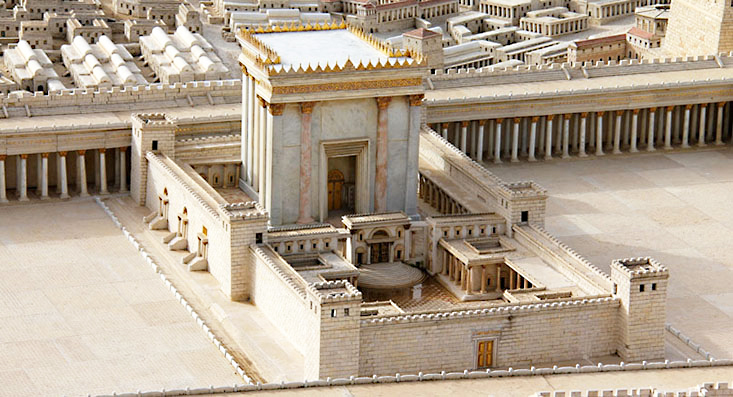 But Herod’s masterpiece remains an extraordinary reconstruction of the Temple of Jerusalem. It was in fact said at the time “that he who has not seen Herod’s Temple has seen nothing beautiful in his life”. Herod employed 10,000 workers and the spaces reserved for religious practice were built exclusively by a thousand priests. It took ten years to build the retaining walls around the Temple Mount. The Western Wall (also called Kotel or “Wailing Wall”) was only part of this 500-metre long retaining wall, designed to contain a huge artificial esplanade.
But Herod’s masterpiece remains an extraordinary reconstruction of the Temple of Jerusalem. It was in fact said at the time “that he who has not seen Herod’s Temple has seen nothing beautiful in his life”. Herod employed 10,000 workers and the spaces reserved for religious practice were built exclusively by a thousand priests. It took ten years to build the retaining walls around the Temple Mount. The Western Wall (also called Kotel or “Wailing Wall”) was only part of this 500-metre long retaining wall, designed to contain a huge artificial esplanade.
Image : A model reconstructing the Temple of Herod exhibited at the Israel Museum in Jerusalem. © Museum of Israel.
As Herod began to develop veneration for the emperor, he undertook along with the priests of Jerusalem to rebuild the Temple. The project was absolutely gigantic and the work lasted nearly 80 years…! That is to say, it concerned the three generations of Herodians who were at the head of Judea. Started around 20/19 B.C., the work was not completed until 64 A.D. Herod did not see the end of his project, but the work was well advanced by the time of his death. The Temple itself was finished and the effort was focused on the huge porticoes built on the periphery and on the surrounding wall.
Herod’s idea, taken from the text by Flavius Josephus (Jewish Antiquities, Book XV), was to enlarge the dimensions of the Temple enclosure from the time of Zorobabel and to raise the site to a more imposing height.
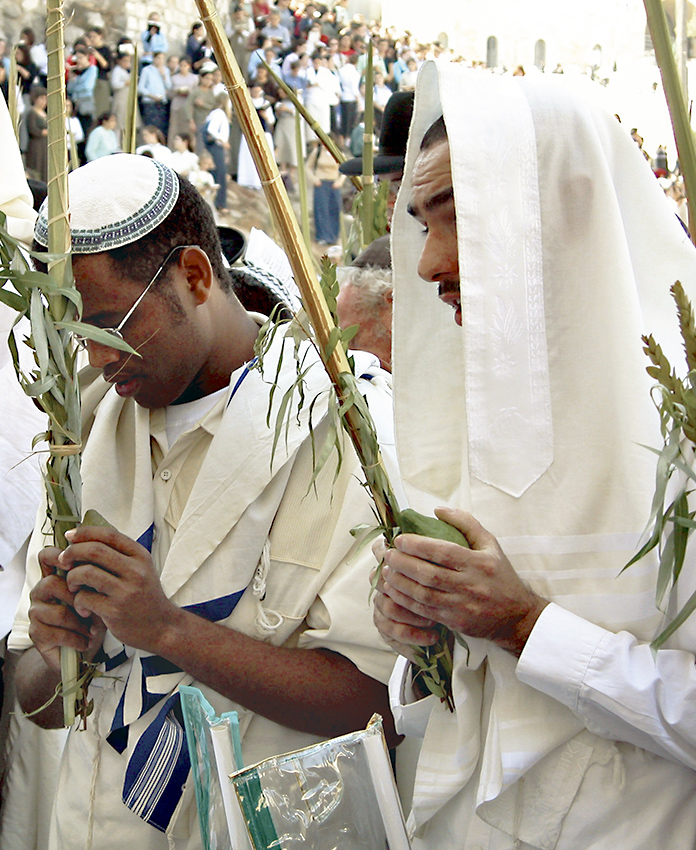 The Temple of Jerusalem had to have the necessary dimensions to accommodate the crowds of pilgrims coming from all over the Diaspora. A city entirely devoted to daily divine worship of great originality, Jerusalem was even more lively three times a year during the great festivals of Pesach (Passover in spring), Shavuot (harvest in summer) and Sukkot (huts in autumn). Infinite precautions were taken so that worship could continue to be rendered under these conditions and so that the laws concerning purity could be scrupulously respected.
The Temple of Jerusalem had to have the necessary dimensions to accommodate the crowds of pilgrims coming from all over the Diaspora. A city entirely devoted to daily divine worship of great originality, Jerusalem was even more lively three times a year during the great festivals of Pesach (Passover in spring), Shavuot (harvest in summer) and Sukkot (huts in autumn). Infinite precautions were taken so that worship could continue to be rendered under these conditions and so that the laws concerning purity could be scrupulously respected.
Image : In front of the Kotel, Orthodox Jews celebrate the festival of the huts (Sukkot). It commemorates the journey of the Hebrew people through the desert. © Todd Bolen.
In 10 AD the Dedication of the Temple was celebrated. This feast of Dedication should not be confused with the one mentioned in John 10,22, which concerns the Dedication of the Temple during the Maccabean revolt. Occupied by the Seleucids (Greeks), Jerusalem was taken over by Judah Maccabeus (164 B.C.) the Temple was cleansed and the worship of the Lord was restored. This event is still commemorated by the Jewish feast of Hanukkah, also known as the “Feast of Enlightenment” (November or December depending on the calendar).
Its destruction
In order to understand the rebellion of 66 which led to the destruction of the Temple and Jerusalem by the Roman army, it is useful to take into account the increase in religious conflicts as well as the political protests exacerbated by the presence of foreigners.
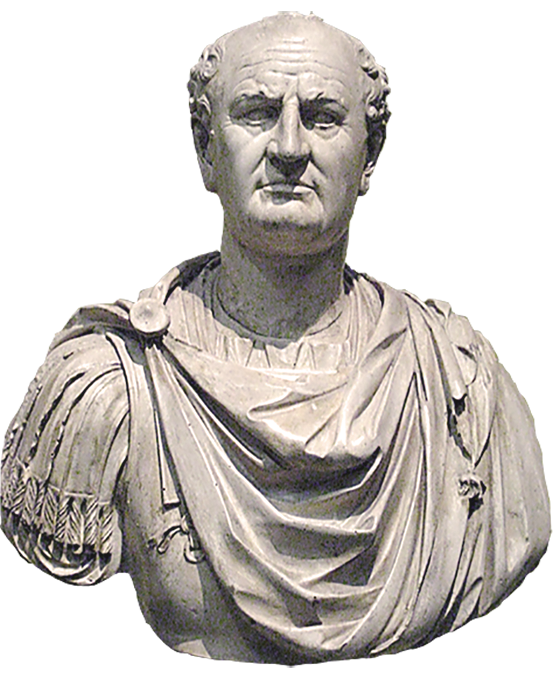 Vespasian, one of the best generals of the Empire, put at the head of an army of 60,000 men, received the order to end it all. Accompanied by his son Titus, he subdues Galilee and takes Tiberias. In 68, Judea is isolated and the rebels have control only over Jerusalem, Bethlehem and Masada on the Dead Sea.
Vespasian, one of the best generals of the Empire, put at the head of an army of 60,000 men, received the order to end it all. Accompanied by his son Titus, he subdues Galilee and takes Tiberias. In 68, Judea is isolated and the rebels have control only over Jerusalem, Bethlehem and Masada on the Dead Sea.
At the beginning of 70, Titus, with four legions, laid siege to Jerusalem protected by its three walls. Opposite, if one relies on the information provided by Flavius Josephus, the Jews had 20,000 armed men at their disposal. The Romans filled in the ditches, put their war machines in position and on May 25th, Titus seized the first rampart. On May 30th, the second. Titus offered to the insurgents the possibility of surrendering, and although famine was prevailing in the city, they refused. Titus conquered the city completely and on July 20th, the Antonia citadel was taken. On August 27th, the final assault was given to the Temple and it was set on fire.
Image : bust of the emperor Vespasian, founder of the Flavian dynasty,
Louvre Museum. © Shako.
All that was left was to attack Masada which had become the refuge of the last zealots commanded by Eleazar. The Herodian fortress was taken on May 2, 73. It is believed that the 960 people still resisting killed themselves with the exception of two women and five children. One million one hundred thousand people are believed to have died in the fighting or as a result of famine.
Judea lost all autonomy. The didrachma that was once poured into the Temple of Yahweh was now being poured into the Temple of Jupiter. The land of Israel was reduced to a consular colony. When Titus returned to Rome victorious, he received a triumphant welcome from his father Vespasian, who had left it to him to complete this campaign. The spoils and prisoners were displayed throughout the city for all to see.
Une maquette reconstituant le Temple de Jérusalem au temps d’Hérode le Grand. © Musée d’Israël, Jérusalem.
Une maquette reconstituant le Temple de Jérusalem au temps d’Hérode le Grand.
Maquette de la reconstitution de la forteresse Antonia accolée au Temple érigé par Hérode le Grand. © D.R.
Maquette de la reconstitution de la forteresse Antonia accolée au Temple.
Vue générale de Jérusalem aujourd’hui, du Mont des Oliviers. © D.R.
Vue générale de Jérusalem aujourd’hui, du Mont des Oliviers.
